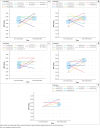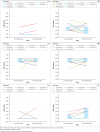Detecting change in a caregiver-mediated autism intervention using the Joint Engagement Rating Inventory
- PMID: 41055175
- PMCID: PMC12505911
- DOI: 10.4102/sajcd.v72i1.1102
Detecting change in a caregiver-mediated autism intervention using the Joint Engagement Rating Inventory
Abstract
Background: The Joint Engagement Rating Inventory (JERI) can be used to measure response to early autism intervention. However, little is known about the utility of the JERI outside the United States, where it was developed. A South African study found the JERI to be a reliable and accurate measure of joint engagement and communication between young autistic children and their caregivers. The next step was to determine if the JERI could be used to detect changes in the behaviours of child and caregiver in response to intervention.
Objectives: This proof-of-principle study aimed to evaluate whether the JERI could detect signals of change in the behaviours of child and caregiver in response to 12, 1-h naturalistic developmental behavioural intervention-informed caregiver coaching sessions.
Method: A single-arm pre-post design was utilised. Standardised video-recorded caregiver-child interactions were completed before and after intervention. Two raters, blinded to intervention time-point, coded the JERI. Ten dyads completed coaching and video-recorded assessments. Data analysis included inter-rater reliability, Wilcoxon signed-rank test for paired samples and visual summaries.
Results: Weighted Kappa values for 13 of the 16 JERI items indicated moderate to strong inter-rater agreement. Significant changes in symbol-infused joint engagement (z = -2.46, p = 0.01) and expressive language (z = -2.156, p = 0.03) were detected. Visual summaries showed change signals in 15 JERI ratings.
Conclusion: Findings suggest that the JERI has the potential to detect change in the context of a caregiver-mediated intervention.Contribution: The JERI was shown here, for the first time in an African context, to be a potential outcome measure for early autism intervention research.
Keywords: Joint Engagement Rating Inventory (JERI); caregiver coaching; intervention response; naturalistic developmental behavioural interventions (NDBI); signals of change.
Conflict of interest statement
The authors reported that they received funding from National Institutes of Mental Health, which may be affected by the research reported in the enclosed publication. The authors have disclosed those interests fully and have implemented an approved plan for managing any potential conflicts arising from their involvement. The terms of these funding arrangements have been reviewed and approved by the affiliated university in accordance with its policy on objectivity in research.
The authors declare that they have no financial or personal relationships that may have inappropriately influenced them in writing this article. The author, M.H., serves as an editorial board member of this journal. The peer review process for this submission was handled independently, and the author had no involvement in the editorial decision-making process for this manuscript. The authors have no other competing interests to declare.
Figures





References
-
- Beaudoin, A.J., Sébire, G., & Couture, M. (2019). Parent-mediated intervention tends to improve parent-child engagement, and behavioral outcomes of toddlers with ASD-positive screening: A randomized crossover trial. Research in Autism Spectrum Disorders, 66, 101416. 10.1016/j.rasd.2019.101416 - DOI
MeSH terms
Grants and funding
LinkOut - more resources
Full Text Sources
Medical
